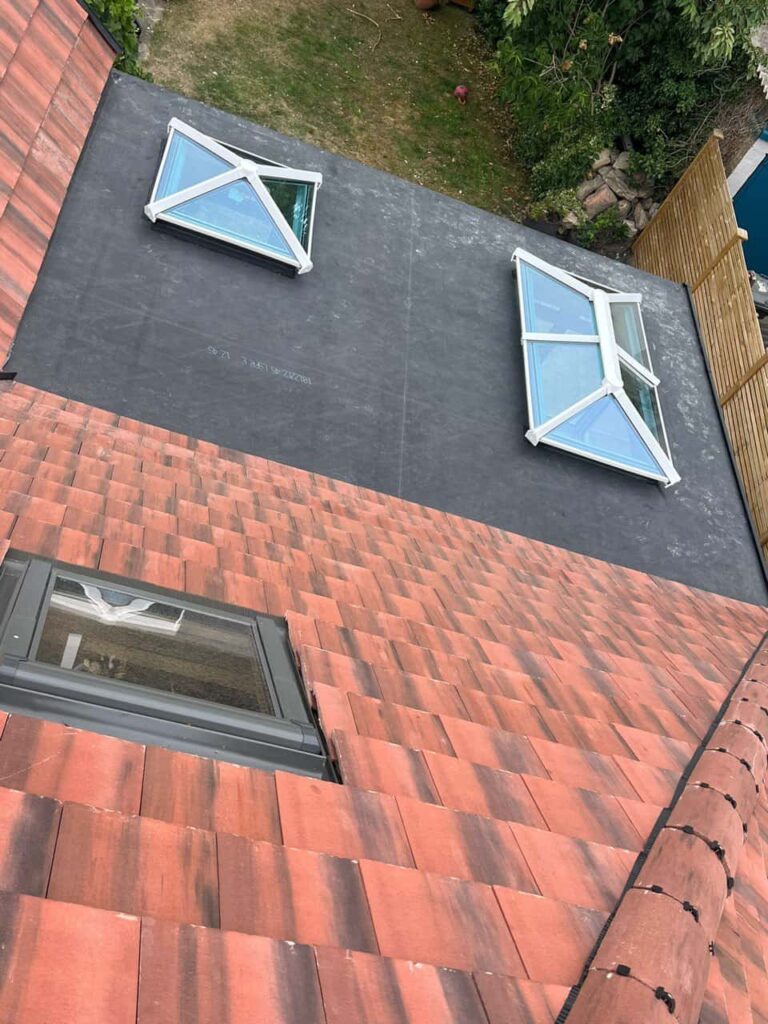Introduction
Roof design plays a pivotal role in the structural integrity and performance of a building, especially when it comes to withstanding adverse weather. One of the most underestimated threats to roofing structures in the UK is lateral wind load — the pressure exerted horizontally by strong winds. In areas such as Gamston, Nottingham, where the British weather can turn quickly, choosing the right roof structure is critical.
Among the various roof designs available, hip roofs consistently perform better in high-wind environments. At Gamston Roofing Repairs, we’ve worked on a wide variety of roofing projects, and we’ve seen first-hand how hip roofs provide greater stability and resistance against wind uplift and lateral force. In this article, we’ll explain what makes hip roofs such an effective defence and why they’re an excellent choice for properties looking to withstand the test of the elements.
What Is a Hip Roof?
A hip roof is a design where all sides of the roof slope downwards to the walls — usually with a fairly gentle slope. Unlike a gable roof, which has only two sloped sides and vertical ends, a hip roof has no vertical surfaces at all.
Key characteristics:
- Four sloped roof faces.
- All sides meet at a central ridge or point.
- Uniform eaves around all sides of the building.
The design gives the roof a pyramidal or trapezoidal appearance, depending on the building’s footprint, and plays a major role in its performance against wind loads.
Understanding Lateral Wind Load
Lateral wind load refers to the horizontal pressure exerted by wind moving across a building. This pressure can be especially damaging when it hits vertical surfaces such as gable ends, causing stress on both the roof and wall structures.
Potential problems caused by lateral wind loads:
- Uplift of roof sections leading to dislodged tiles or complete failure.
- Pressure on gable ends causing wall cracks or collapses.
- Water ingress due to forced wind-driven rain under the roofing material.
These effects can be more pronounced in exposed or elevated areas around Gamston, where strong gusts funnel across open fields or urban spaces.
Why Hip Roofs Are More Wind-Resistant
The sloped design of hip roofs makes them naturally more aerodynamic. Because there are no vertical ends for the wind to directly strike, the forces are dispersed across the surface, reducing overall pressure.
Benefits of hip roofs in windy conditions:
- Reduced wind uplift: The slope on all four sides allows wind to pass over smoothly, limiting the chance of tiles lifting or the structure buckling.
- Better load distribution: Forces are evenly spread across the roof frame and walls, reducing the risk of failure at weak points.
- No gable walls: Without tall vertical gable ends, there’s less surface area for wind to push against, lowering the risk of structural damage.
This efficient force distribution is particularly valuable for detached homes and properties situated in open or rural areas of Nottinghamshire.
Structural Advantages in Long-Term Durability
Beyond wind resistance, hip roofs provide several construction and longevity benefits, all of which contribute to a more robust and resilient roofing solution.
Structural strengths include:
- Increased bracing due to diagonal rafters.
- Better support against lateral loads on all sides.
- Lower centre of gravity for the roof mass, reducing sway.
These features collectively enhance the performance of hip roofs in adverse weather, giving homeowners extra peace of mind during storm seasons.
Ideal Settings for Hip Roofs
Hip roofs are particularly suited for:
- Properties in open countryside or hilltop positions where wind exposure is greater.
- Suburban homes with little surrounding shelter or where consistent weather protection is required.
- New builds and roof replacements looking for added structural integrity with a stylish design.
In places like Gamston, where the landscape often provides little natural wind shielding, choosing a hip roof can be a smart long-term investment in protection and resilience.
Maintenance Considerations
Because hip roofs have fewer exposed edges and uniform slopes, they generally experience:
- Less wear and tear on ridge tiles and flashing.
- Fewer repair points due to wind-driven damage.
- Better overall drainage performance, reducing pooling and moss growth.
That said, they can be slightly more complex to construct and repair due to their additional corners and joins. However, when installed by experienced professionals like Gamston Roofing Repairs, these challenges are easily overcome with precision workmanship and quality materials.
Conclusion
When it comes to resisting the effects of lateral wind loads, hip roofs stand out as one of the most structurally sound choices for both new builds and re-roofing projects. Their sloped design reduces wind impact, evenly distributes pressure, and eliminates vulnerable gable ends — all of which contribute to long-term performance in harsh weather.
At Gamston Roofing Repairs, we believe in delivering solutions that not only look good but also stand up to the environment they’re placed in. If you’re considering a new roof or replacing an existing one in Gamston or the surrounding Nottinghamshire area, a hip roof could be your best defence against future wind damage. Contact us today to discuss your roofing needs with our expert team.
Call us on: 0115 647 1193
Click here to find out more about Gamston Roofing Repairs
Click here to complete our contact form and see how we can help with your roofing needs.

